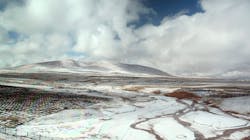Irreversible water storage declines predicted in parts of Asia by 2060
The Tibetan Plateau, known as the “water tower” of Asia, supplies freshwater for nearly two billion people who live downstream. New research led by scientists at Penn State, Tsinghua University and the University of Texas at Austin projects that climate change, under a scenario of weak climate policy, will cause irreversible declines in freshwater storage in the region, constituting a serious the water supply for central Asia and Afghanistan and a near-total collapse for Northern India, Kashmir, and Pakistan by the middle of the century.
“The prognosis is not good,” said Michael Mann, distinguished professor of atmospheric science, Penn State. “In a ‘business as usual’ scenario, where we fail to meaningfully curtail fossil fuel burning in the decades ahead, we can expect a substantial decrease — that is, nearly 100 percent loss — of water availability to downstream regions of the Tibetan Plateau. I was surprised at just how large the predicted decrease is even under a scenario of modest climate policy.”
According to the researchers, despite its importance, the impacts of climate change on past and future terrestrial water storage (TWS) — which includes all the above- and below-groundwater — in the Tibetan Plateau have largely been underexplored.
“The Tibetan Plateau supplies a substantial portion of the water demand for almost two billion people,” said Di Long, associate professor of hydrologic engineering, Tsinghua University. “Terrestrial water storage across this region is crucial in determining water availability, and it is highly sensitive to climate change.”
Mann added that a solid benchmark for the TWS changes that have already occurred in the Tibetan Plateau has been lacking. In addition, he said, the absence of reliable future projections of TWS limits any guidance on policymaking, despite the fact that the Tibetan Plateau has long been considered a climate change hotspot.
To fill these knowledge gaps, the team used satellite-based and ground-based measurements of water mass in glaciers, lakes, and below-ground sources, combined with machine learning techniques to provide a benchmark of observed TWS changes over the past two decades (2002‒2020) and projections over the next four decades (2021–2060).
Mann explained that advances in Gravity Recovery and Climate Experiment (GRACE) satellite missions have provided unprecedented opportunities to quantify TWS changes at large scales. Yet, previous studies have not explored the sensitivity of GRACE solutions using independent, ground-based data sources, leading to a lack of consensus regarding TWS changes in the region.
“Compared to previous studies, establishing consistency between top-down and bottom-up approaches is what gives us confidence in this study that we can accurately measure the declines in TWS that have already occurred in this critical region,” he said.
Next, the researchers used a novel neural net-based machine learning technique to relate these observed changes in total water storage to key climate variables, including air temperature, precipitation, humidity, cloud cover, and incoming sunlight. Once they ‘trained’ this artificial neural net model, they were able to look at how projected future changes in climate are likely to impact water storage in this region.
Among their results, published in the journal Nature Climate Change, the team found that climate change in recent decades has led to severe depletion in TWS (-15.8 gigatons/year) in certain areas of the Tibetan Plateau and substantial increases in TWS (5.6 gigatons/year) in others, likely due to the competing effects of glacier retreat, degradation of seasonally frozen ground, and lake expansion.
The team’s projections for future TWS under a moderate carbon emissions scenario — specifically, the mid-range SSP2-4.5 emissions scenario — suggest that the entire Tibetan Plateau could experience a net loss of about 230 gigatons by the mid-21st century (2031‒2060) relative to an early 21st century (2002‒2030) baseline.
More specifically, excess water loss projections for the Amu Darya basin — which supplies water to central Asia and Afghanistan — and the Indus basin — which supplies water to Northern India, Kashmir and Pakistan — indicate a decline of 119 percent and 79 percent in water-supply capacity, respectively.
Mann noted that more alternative water supply sources, including intensified groundwater extraction and water transfer projects, may be necessary to meet the amplified water shortage in the future.
